Friday, March 21, 2008
No. 125 - Fine Arts Building
Fine Arts Building
1926 – Albert Walker and Percy Eisen
811 West Seventh Street – map
Declared: 4/17/74
The lobby of the Fine Arts Building is amazing in its ornamentation. However, I was stopped from taking any pictures because, naturally, indoor photography isn’t allowed. When I asked him why that is, a security guard came up with, “Building policy.” Well, that answers that. I knew there had to be a good reason.
Built for artists and craftsmen to develop their works, the twelve-story monument was designed by the firm of Albert Walker and Percy Eisen in the Romanesque Style. It’s been known as a few titles in its eighty-year history – the Fine Arts, Signal Oil, and Havenstrite Buildings, and then, beginning in 1969, the Global Marine House. In the early 1980s, at the cost of $17 million, Ratkovich, Bowers Inc. purchased and, with the help of Brenda Levin Associates and Gensler & Associates, restored the landmark just like they had done for the Oviatt Building downtown and were doing for the Pellissier Building. Also, the owners switched the name back to the Fine Arts Building upon its reopening in 1983.
The terra cotta was provided by, as for the Pellissier and Garfield landmarks, the Gladding, McBean & Company. The stunning 3,000 square-foot lobby features murals by A.B. Heinsbergen and is encircled by seventeen display cases, originally for showing tenants’ artwork but holding photos of old L.A. when I was there (I mean when I was there at the Fine Arts Building, not when I was there in old L.A.). Bordering on over-the-top in decorative artwork from floor to ceiling, the lobby is slathered in tilework by Ernest Batchelder.
Builders Edwards and Wildey hired one of Southern California’s best-known sculptors, Burt William Johnson, to decorate their building. Johnson went on to create two hefty statues, a pair of large outdoor panels, and a bunch of smaller pieces for the building before dying of a heart attack. His two sculpts, “Architectvre” and “ Scvlptvre”, can be seen lounging outside the ninth floor. Here's "Scvlptvre", and try not to get a crick in your neck looking.
Johnson was born in Flint, Ohio, studied at the Art Students’ League in New York, and ended up in Southern California when he was seventeen. During his Fine Arts commission, Johnson’s health was permanently affected from a bout with influenza in June 1926. He returned to his Claremont studio in the fall, directing assistants Merrill Gage, Mrs Annetta St Gaudens (his sister), Hall St Gaudens (his nephew), and Gilbert Morgan from his bed and wheelchair. While the building was opened to the public the previous December, Johnson was still working on the project in March 1927 when he died of a heart attack in his Claremont home. He was only 37. According to his Los Angeles Times obituary, on the day he passed away he was working on one of the Hermae statues for the Fine Arts Building, modeling it on his daughter, Cynthia Mae. He also used the girl as the basis for a pair of bronze sculptures in the lobby’s fountain. Those bronzes, cast by the Gorham Company, can be seen in this shot from the Los Angeles Department of City Planning website (they're the smaller ones at either end of the pool):
Seriously. If you’ve never poked your head inside the Fine Arts Building, you owe it to yourself to do so. But, please, for the sake of humanity, don’t take any pictures.
Oh. And, sadly, the Fine Arts Building is no longer home to either the Cap 'N Quill or the Pig ‘N Whistle restaurants.
Sources:
“Sculptor Wins in Life Fight” Los Angeles Times; Dec 12, 1926, p. B9
Francis D. Duncan “Burt W. Johnson” Los Angeles Times; Mar 29, 1927, p. A4
Evelyn De Wolfe “Landmark Renovated” Los Angeles Times; Oct 9, 1983, p. I1
Up next: Shakespeare Bridge
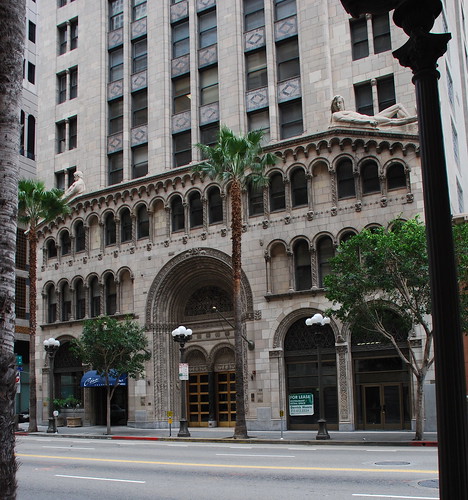
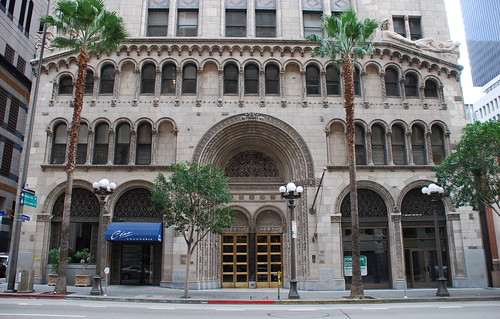

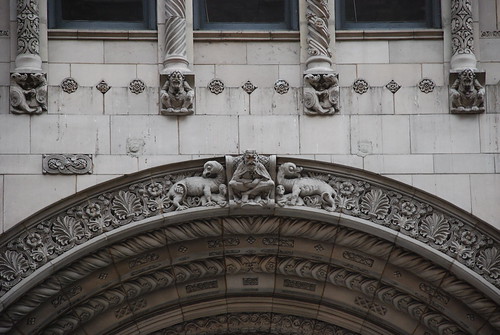
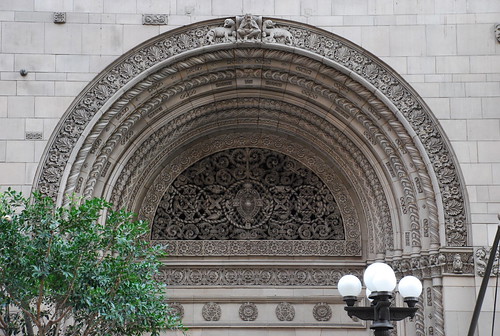
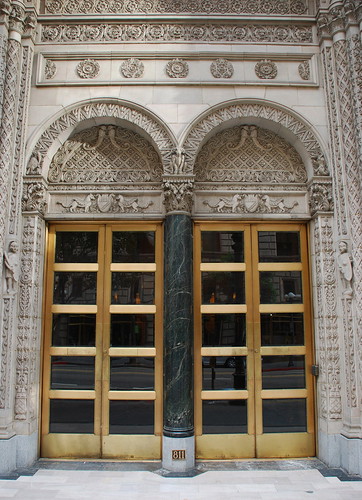

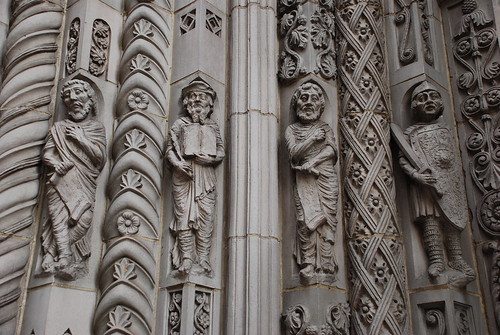
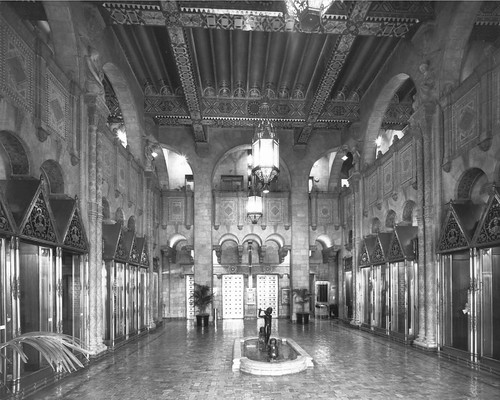
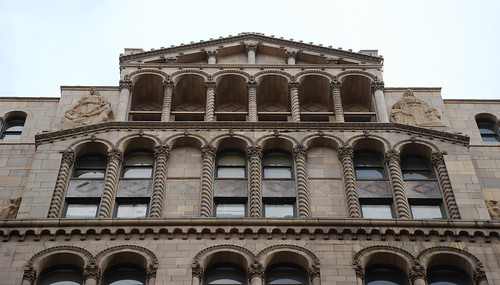
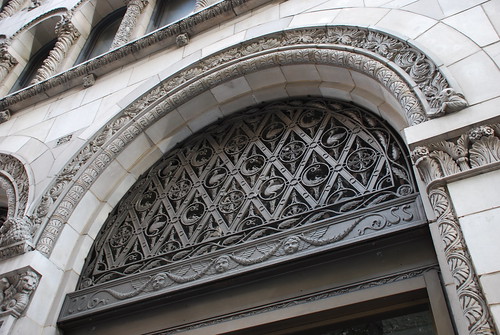

That is a beautiful building.
ReplyDeleteHello Floyd -- This is truly a spectacular building. Seems so European. The carved figures have the feel of Notre Dame. I like the bas-relief statues at the top of the building, but I have always hated the hideous and grotesque “Architectvre” and “Scvlpuvre” statues at the 9th floor. I’d have preferred something different or nothing at all. Although I always favor restoration over remodeling or re-muddling (the term used by preservationist), their removal would be an improvement. Of course, that will never happen with monument status. I just wish the ugliness of those two could be explained that I might acquire some appreciation. There used to be a McDonalds on the right corner of the building. I’d eaten there on many occasion over the years. It had a second floor split level loft where one could dine among the ceiling carvings. I don’t know the height of that ceiling, but from the photos one can see that the first floor is as tall as two story. The McDonalds closed a couple years ago, though why I don’t know. It was always busy, as was the Burger King in the historic building across the street (7th Street) which has also closed. Though I diverse, across the cross street (Flower Street) is another historic building. The two rail lines (subway red and light rail blue) meet below this building which provides the station entry and exit. There is currently work going on in this building. As I recall, they are converting it from office space into residential space. It had and I hope still has a spectacular entry lobby with and elegant marble balustrade stairway. Let’s cross our fingers and hope they do a good job. -- Robert
ReplyDeleteWell, Robert, the building's just been sold to Brian Kabateck and Mark Geragos for $23.5 million, so we'll soon see what changes are made, if any. I vote for the return of the Pig 'n Whistle.
ReplyDeleteThese are great pictures. I hope you don't mind if I post one or two on my blog. My office was in this building for about 12 years. I never got tired of walking through the amazing lobby.
ReplyDeleteThanks, Joe. Post whatever you'd like. If you come back here and leave a link, that'd be great.
ReplyDeleteI worked in this building in the late sixties and early seventies for a firm of patent attorneys. It was a magnificent building then and it is now. The lobby looks remarkably the same. It was certainly a different time. There were actual elevator operators. I have been out of the area for years and hope the surrounding real estate development does this building justice. I remember a different restaurant. I think it was the "Pen and Quill" or something like that.
ReplyDeletehttp://blogdowntown.com/2009/08/4592-pig-n-whistle-finalizing-plans-to-return
ReplyDeleteYou may get your wish about the Pig n Whistle returning to the building.
Thank you for the photos of my grandfather's sculptures. Yes, as you wrote, my mother Cynthia and her brother Harvey posed for the children in the fountain sculpture. My mother remembers posing, at age three, for her beloved father Burt Johnson. Several of my family members have visited the building and equally enjoyed seeing our grandfather's works.
ReplyDelete